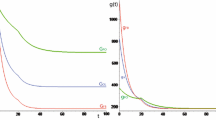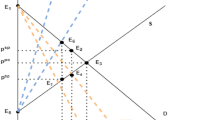Abstract
In this paper, we focus on resource conservation in a model of decentralized management of groundwater and rainwater. We show that a conservation policy may have opposite effects on the level of the resource, depending on the outcome of the decentralized management. More precisely, we consider identical farmers who can use two water resources (groundwater and/or rainwater) and we study the symmetric and asymmetric feedback stationary Nash equilibria of the dynamic game. We show that a subsidy on the use of rainwater may increase the level of the aquifer at the symmetric equilibrium, whereas it decreases the level of the aquifer at the asymmetric equilibrium. This suggests that the usual focus on (interior) symmetric equilibria in dynamic games may provide misleading policy implications.
Similar content being viewed by others
Notes
In Europe’s biggest crop production area, in the center and north of France, where farmers have access to both groundwater and rainwater resources, water taxes are differentiated such that rainwater use is relatively less expensive than groundwater use. This policy aims at preserving groundwater resources and is intended to be strengthened over the next couple of years, with increasing differences in tax rates being scheduled (see 10th Programme of the Seine-Normandie Water Agency).
See, for instance, the Texas Tax Code 152.355.
Dockner et al. (2000) argue that “one can often take advantage of symmetries. For example if the game is completely symmetric [\(\ldots \)] one can try to find a symmetric Nash equilibrium”. Rowat (2002) uses computational techniques to identify the Markov perfect equilibria in a two symmetric agent differential game with bounded controls. He finds no evidence of asymmetric equilibria. However he focuses on linear quadratic differential games and interior solutions.
For simplification, we do not take into account the local percolation and discharge. When the water table is near the ground surface, there is little opportunity for recharge and shallow aquifers are recharged by local percolation of surface water and discharged by crops that use the water out of the ground. However, large aquifers run deep and are highly dependent on rain and melting snow.
As we focus on irrigation strategies, water is the only input considered.
We consider a “bathtub” type aquifer, and then the cost is the same at each point of the aquifer.
We remove the argument \(t\) to relieve the expressions.
Assume that the other farmers increase their use of groundwater and rainwater when the height of the watertable increases, i.e. \({\sum \nolimits _{j\ne i}}\left( \rho \frac{\partial \phi _{rj}}{\partial h}+\frac{\partial \phi _{gj}}{\partial h}\right) \), and \(p_{i}>0\). Hence, the shadow price of groundwater for farmer \(i\) may be increasing (see necessary condition (12)). In such a situation, farmer \(i\) has incentives to increase its use of groundwater and rainwater.
See the proof of Proposition 4.
In the “Appendix”, we show that the two first statements (a decrease in the cost of rainwater use increases rainwater use and decreases groundwater use) can be extended to the case of the general model. The third statement can be generalized to the case of the general model if \(n_{g}=1\). See the proof of Proposition 4 in Appendix.
Also note that the optimal levels of \(h,w_{g},w_{r}\) are constant. If \(h_{0}=h\) the optimal solution is to keep \(\dot{h}\left( t\right) =0\), for all \(t\). If this is not the case, it remains to study the transitory path.
References
Burt OR (1964) The economics of conjunctive use of ground and surface water. Hilgardia 36(2):31–111
Chakravorty U, Umetsu C (2003) Basinwide water management: a spatial model. J Environ Econ Manag 45:1–12
Cummings RG (1971) Optimum exploitation of groundwater reserves with saltwater intrusion. Water Resour Res 7(6):1415–1424
Dockner EJ, Jorgensen S, Long NV, Sorger G (2000) Differential games in economics and management science. Cambridge University Press, Cambridge, 350 p
Gemma M, Tsur Y (2007) The stabilization value of groundwater and conjunctive water management under uncertainty. Rev Agricu Econ 29(3):540–548
Gisser M, Sanchez DA (1980) Competition versus optimal control in groundwater pumping. Water Resour Res 31:638–642
IPCC (2007) Climate change: synthesis report. Geneva, Switzerland, 104 pp
Johnson N, Revenga C, Echeverria J (2001) Managing water for people and nature. Science 11, 292 (5519), 1071–1072
Knapp KC, Olson LJ (1995) The economics of conjunctive groundwater management with stochastic surface supplies. J Environ Econ Manag 28:340–356
Koundouri P (2004) Current issues in the economics of groundwater resource management. J Econ Surv 18(5):703–740
Krulce DL, Roumasset JA, Wilson T (1997) Optimal management of a renewable and replacable resource: the case of coastal groundwater. Am J Agric Econ 79:1218–1228
Moreaux M, Reynaud A (2004) Optimal management of a coastal aquifer and a substitute resource. Water Resour Res 40:1–10
Moreaux M, Reynaud A (2006) Urban freshwater needs and spatial cost externalities for coastal aquifers: a theoretical approach. Reg Sci Urban Econ 36:163–186
Negri DH (1989) The common property aquifer as a differential game. Water Resour Res 25(1):9–15
Ostrom E (1990) Governing the commons: the evolution of institutions for collective action. Cambridge University Press, New York
Pandey DN (2001) A bountiful harvest of rainwater. Science, 7, 293 (5536), 1763
Pongkijvorasin S, Roumasset J (2007) Optimal conjunctive use of surface and groundwater with recharge and return flows: dynamic and spatial patterns. Rev Agric Econ 29(3):531–539
Roseta-Palma C (2003) Joint quantity/quality management of groundwater. Environ Resour Econ 26:89–106
Roumasset JA, Wada CA (2012) Ordering the extraction of renewable resources: the case of multiple aquifers. Resour Energy Econ 34:112–128
Rowat C (2002) Asymmetric play in a linear quadratic differential game with bounded controls. Working paper 02–12, University of Birmingham, Department of Economics, 2002
Rubio SJ, Casino B (2001) Competitive versus efficient extraction of a common property resource: the groundwater case. J Econ Dyn Control 25:1117–1137
Rubio SJ, Casino B (2003) Strategic behavior and efficiency in the common property extraction of groundwater. Environ Resour Econ 26(1):73–87
Stahn H, Tomini A (2009) A drop of rainwater against a drop of groundwater: does rainwater harvesting really spare groundwater? DT GREQAM 2009-43
Stahn H, Tomini A (2011) Rainwater harvesting under endogenous capacity of storage: a solution to aquifer preservation? Annals of Economics and Statistics
Tsur Y, Graham-Tomasi T (1991) The buffer value of groundwater with stochastic surface water supplies. J Environ Econ Manag 21:201–224
Zeitouni N, Dinar A (1997) Mitigating negative water quality and quality externalities by joint management of adjacent aquifers. Environ Resour Econ 9:1–20
Author information
Authors and Affiliations
Corresponding author
Additional information
We acknowledge financial support from the ANR project “RISECO”, ANR-08-JCJC-0074-01.
Appendix
Appendix
1.1 Proof of Proposition 4
We first show a preliminary result. Since we focus on asymmetric equilibria with specialized farmers, we have \(n_{g}\ge 1,n_{r}\ge 1\) and \(n_{b}=0\).
Lemma 1
Assume that \(w_{r}^{A}\), the solution of \(\max _{w_{r}}\left[ F(\theta w_{r})-C_{r}(w_{r})\right] \), is positive and let \(\bar{R}\equiv R-n_{r}w_{r}^{A}>0\). Also, assume that
has a solution such that \(w_{gi}^{A}(t)>0\) for all \(i\in G \) and \(h(t)>0\) for all \(t\). Then, \(w_{ri}=w_{r}^{A}\) for all \(i\in R\) and \(w_{gi}=w_{gi}^{A} \) for all \(i\in G\) is a feedback equilibrium of our differential game.
Proof of Lemma 1
Suppose that a feedback equilibrium with \(n_{g}\ge 1,n_{r}\ge 1,\,n_{b}=0\) and \(h(t)>0\) exists. Let \(V_{gi}\) be the value function of player \(i\) in group \(G\) and \(V_{ri}\) the value function of player \(i\) in group \(R\). Let \(\phi _{gi}\) be the feedback equilibrium strategy of groundwater use for player \(i\) in group \(G\) and \(\phi _{ri}\) be the feedback equilibrium strategy \(i\) in group \(R\). These value functions are a solution of the following Hamilton-Jacobi-Bellman equations:
and,
Now, let us define the following strategies. Let \(\phi _{r}=arg\max _{w_{g}}\left[ F(\theta w_{g})-C_{r}(w_{g})\right] \). We have
and
and \(\bar{R}=R-n_{r}\phi _{r}\). Notice that \(\phi _{r}\) is a constant and it does not depend on \(h\). Also, \(\bar{V}_{r}\) does not depend on \(h\).
Let \(\phi _{g}^{i}\) be the feedback Nash equilibrium strategy of player \(i\) of the following differential game:
The associated HJB equation is
Suppose that the feedback Nash equilibrium is such that \(h(t)>0\). Hence \(\bar{V}_{gi}(h)\) and \(\bar{V}_{g}\) (with the respective equilibrium strategies) are solutions of (38) and (39). \(\square \)
Now, we can establish the following result:
Lemma 2
There exists an asymmetric SNE with specialized farmers where an increase in the cost of rainwater (through an increase in \(\sigma \)) has the following effect:
Moreover, we have \(\frac{\partial h^{A}}{\partial \sigma }>0\) when \(n_{g}=1\).
Proof of Lemma 2
Let \(C_{r}\equiv \left( 1+\sigma \right) \widetilde{C}_{r}\). Using Lemma 1, we have \(w_{r}^{A}=\max _{w_{r}}\left[ F(\theta w_{r})\right. \left. -\left( 1+\sigma \right) \widetilde{C}_{r}(w_{r})\right] \) and \(\bar{R}\equiv R-n_{r}w_{r}^{A} \). Hence, when \(\sigma \) increases, \(w_{r}^{A}\) decreases and \(\bar{R}\) increases. At the steady state, \(\sum _{i\in G}\phi _{Gi}=\sum _{i\in G}w_{gi}^{A}=\rho \bar{R}\), and then \(\sum _{i\in G}w_{gi}^{A}\) increases with \(\sigma \). If all the players in group \(G\) use the same level of groundwater, then \(w_{gi}^{A}\) increases with \(\sigma \).
Now, let us focus on the case in which \(n_{g}=1\). Since \(w_{r}^{A}\) does not depend on \(h\), we have \(\delta _{i}\left( h\right) =\delta \) for \(i\in G\). Let us show that \(\frac{\partial h^{A}}{\partial \sigma }>0\). We first show that \(\frac{\mu }{\theta }>\frac{1}{\rho }\). Let \(RC_{i}\equiv MC_{gi}(h,w_{gi})/MC_{ri}\left( h,w_{gi},w_{ri}\right) \) denote the ratio of marginal costs, where
and,
Let \(w_{g}^{A}\equiv w_{gi}^{A}\). Using condition (30), condition (33) and because the ratio of
the marginal costs is a decreasing function of \(w_{ri}\), we have
Note that this implies that it is not possible \(\frac{MC_{g}(h,w_{g})}{MC_{r}(h,w_{g},0)}\ge 0\) for all \(w_{g}\in [0,w_{g}^{A}]\) (because if it is the case \(w_{g}^{A}<0\)). Then there must exist \(\widetilde{w}_{g}\in [0,w_{g}^{A}]\) such that the derivative of the ratio of marginal cost, \(\frac{MC_{g}(h,\widetilde{w}_{g})}{MC_{r}(h,\widetilde{w}_{g},0)}\) is negative. Notice that this derivative is:
Hence, we must have
Using (45) and \(\frac{\partial ^{2}C_{g}}{\partial w_{g}^{2}}\ge 0\), we have
This implies
Using (44), we have \(\frac{\mu }{\theta }>\frac{1}{\rho }\).
Differentiating (28) with respect to \(\sigma \), we have
Finally, \(\frac{\partial h^{A}}{\partial \sigma }>0\).
Moreover, in the quadratic linear specification with two players, the SNE with specialized farmers is unique.
1.2 Proof of Proposition 5
We focus on the SNE in which the two farmers use rainwater and groundwater. Assuming that the two farmers use linear strategies, i.e. that farmer \(i\) considers that player \(j\) uses \(w_{gj}=a_{g}h+b_{g}\) and \(w_{rj}=a_{r}h+b_{r} \) and that the value function is quadratic \(V(h)=\frac{A}{2}h^{2}+Bh+C\). The farmer has to solve the following problem:
For this case, first order condition gives:
from these two equations we obtain
This states that the solution is singular solution because \(h\) does not depend on time.Footnote 12 Hence, in equilibrium, we must have \(A=B=0\) and \(\dot{h}=0\). The unique steady state is characterized by:
We can easily deduce that
and
Moreover
with
One can check that \(w_{g}^{S},w_{r}^{S}>0\) implies \(\rho \mu -\theta >0\). Hence \(\frac{\partial w_{g}^{S}}{\partial {\sigma }}=\frac{\partial w_{g}^{S} }{\partial {h}}\frac{\partial {h^{S}}}{\partial {\sigma }}<0\) and \(\frac{ \partial w_{r}^{S}}{\partial {\sigma }}=\frac{\partial w_{r}^{S}}{\partial {h }}\frac{\partial {h^{S}}}{\partial {\sigma }}>0\).
Rights and permissions
About this article
Cite this article
Soubeyran, R., Tidball, M., Tomini, A. et al. Rainwater Harvesting and Groundwater Conservation: When Endogenous Heterogeneity Matters. Environ Resource Econ 62, 19–34 (2015). https://doi.org/10.1007/s10640-014-9813-9
Accepted:
Published:
Issue Date:
DOI: https://doi.org/10.1007/s10640-014-9813-9




